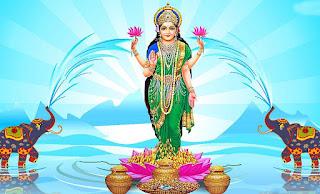Lakshmi is also called Sri or Thirumagal because she is endowed with six auspicious and divine qualities, or gunas, and is the divine strength of Vishnu. In Hindu religion, she was born from the churning of the primordial ocean (Samudra manthan) and she chose Vishnu as her eternal consort. When Vishnu descended on the Earth as the avatars Rama and Krishna, Lakshmi descended as his respective consort.In the ancient scriptures of India, all women are declared to be embodiments of Lakshmi. The marriage and relationship between Lakshmi and Vishnu as wife and husband is the paradigm for rituals and ceremonies for the bride and groom in Hindu weddings.Lakshmi is considered another aspect of the same supreme goddess principle in the Shaktism tradition of Hinduism.
Lakshmi is depicted in Indian art as an elegantly dressed, prosperity-showering golden-coloured woman with an owl as her vehicle, signifying the importance of economic activity in maintenance of life, her ability to move, work and prevail in confusing darkness. She typically stands or sits like a yogin on a lotus pedestal and holds lotus in her hand, a symbolism for fortune, self-knowledge and spiritual liberation. Her iconography shows her with four hands, which represent the four goals of human life considered important to the Hindu way of life: dharma, kāma, artha, and moksha. She is often depicted as part of the trinity (Tridevi) consisting of Saraswati, Lakshmi and Parvati.
Archaeological discoveries and ancient coins suggest the recognition and reverence for Lakshmi by the 1st millennium BCE. Lakshmi's iconography and statues have also been found in Hindu temples throughout southeast Asia, estimated to be from the second half of the 1st millennium CE. The festivals of Diwali and Sharad Purnima (Kojagiri Purnima) are celebrated in her honor.

ॐ महालक्ष्म्यै नमो नम: ।
ॐ विष्णुपृयायै नमो नम: ।
ॐ धनप्रदायै नमो नम : ।
ॐ विश्वजनन्यै नमो नम: ।
ॐ विश्वजनन्यै नमो नम: ।


Post a Comment